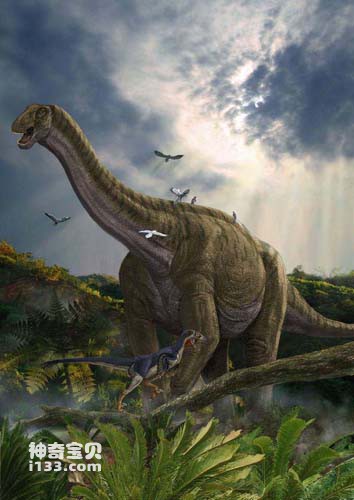The excavation of Yellow River Dragon began in 2002 and lasted for three years. The fossils include: a nearly complete sacral vertebra, a front caudal vertebra, a middle caudal vertebra, several incomplete cervical ribs, and a missing distal vein arc. Left scapula and coracoid. It belongs to the primitive titanosaur-like dinosaur and lived in the Early Cretaceous. Its discovery is of great significance to the study of the origin and early evolution of the titanosaur-type sauropod dinosaur.
In 2004, You Hailu and Ji Qiang from the Institute of Geology, Chinese Academy of Geological Sciences, Li Daqing from China University of Geosciences and other scholars described a new sauropod fossil from the Lower Cretaceous Estuary Group in Lanzhou Basin, Gansu, named Liujiaxia Yellow River Megalosaurus. The genus name Huanghe Julong means the giant dragon on the edge of the Yellow River, and the species name indicates that it was found in the Liujiaxia area of Yongjing County, Gansu Province.
The sacral vertebrae of Yellow River Dragon are unique, with a very low neural ridge that expands laterally at its top. In addition, Yellow River Megalosaurus is also characterized by its wide hips and long forelimbs, making it the fattest dinosaur known in China. It is about 20 meters long. The sacral vertebra (the middle part of the hip bone) is less than half a meter high but 1.1 meters long. The 1.23-meter-long shoulder blade can reach 0.83 meters at its widest point. The largest dinosaur previously discovered in China, Mamenchisaurus, could reach a length of more than 30 meters, but its body was slender. It is speculated that its weight was not as heavy as the newly discovered Yellow River dragon.
The discovery of the Yellow River Titanosaurus adds a new member to the Early Cretaceous titanosaur-type sauropods in Asia. In recent years, there has been great progress in the research on titanosaur sauropods. Titanosaur sauropods are no longer limited to the southern hemisphere. Many new discoveries have been made in the Early Cretaceous of the northern hemisphere, and an independent monophyletic group may also exist in Asia. At the same time, with the discovery of more and more giant sauropods, the traditional Cretaceous terrestrial plant ecosystem dominated by hadrosaurs and ceratopsians is also being challenged.
The dinosaur fossils in the Lower Cretaceous Estuary Group of the Lanzhou Basin have only become known due to the extensive field work of the Paleontological Research and Development Center of the Third Institute of Geology and Mineral Exploration of Gansu Province in recent years, but their potential is huge. Since the late 1990s, a large number of trace fossil groups, mainly dinosaur footprints, have been discovered in the western part of the basin. In 2002, the first dinosaur bone fossil was discovered in the western part of the basin. A dinosaur fossil excavated in 2003 was later studied to be the herbivorous dinosaur with the largest teeth in the world, and was named Megalodon Lanzhousaurus. The Liujiaxia Dinosaur National Geopark established on this basis was officially opened in 2005. A lot of field work is continuing, and a group of vertebrate fossils including fish, turtles and various dinosaurs is being revealed to us.

Chinese name: Yellow River Dragon
Latin name: Huanghetitan
Age of survival: Early Cretaceous
Fossil origin: Gansu, Henan, China
Physical characteristics: 20 meters long
Diet: plants
Species: Sauropod
Definition: The giant dragon from the Yellow River
animal tags: Huanghetitan
We created this article in conjunction with AI technology, then made sure it was fact-checked and edited by a Animals Top editor.